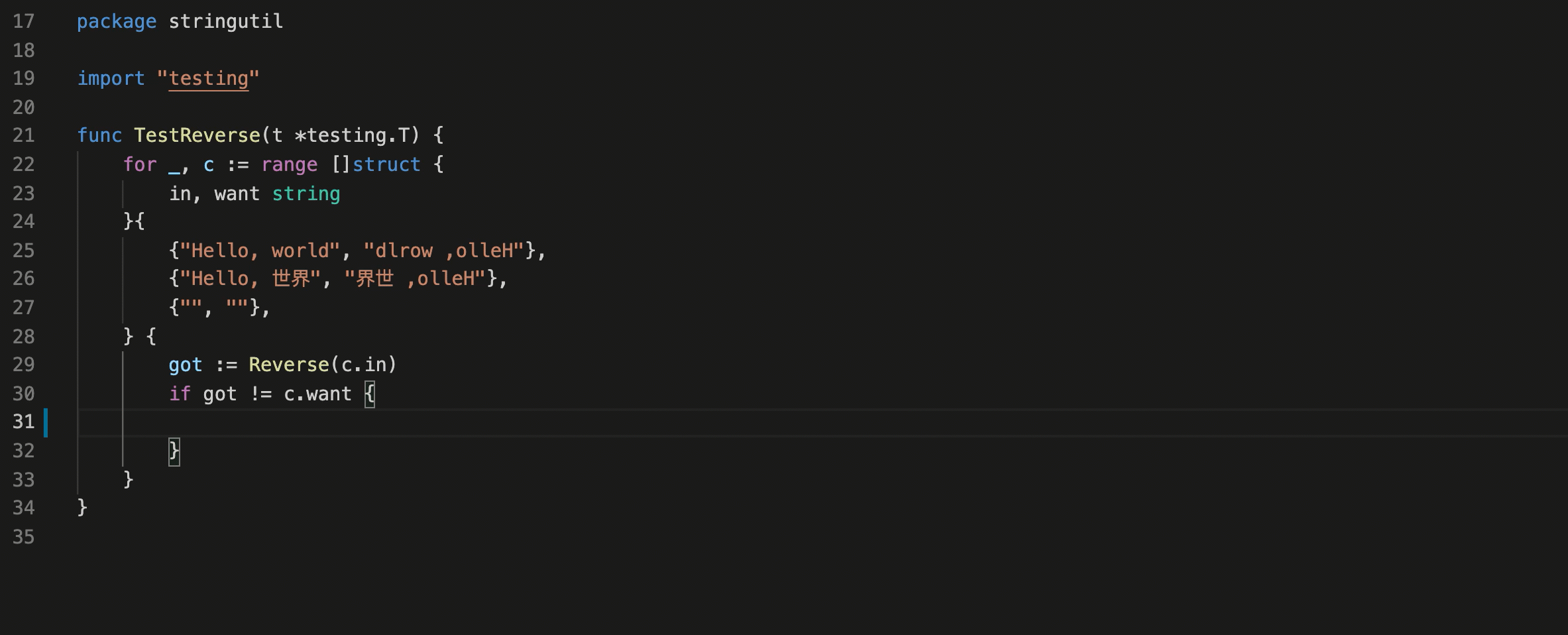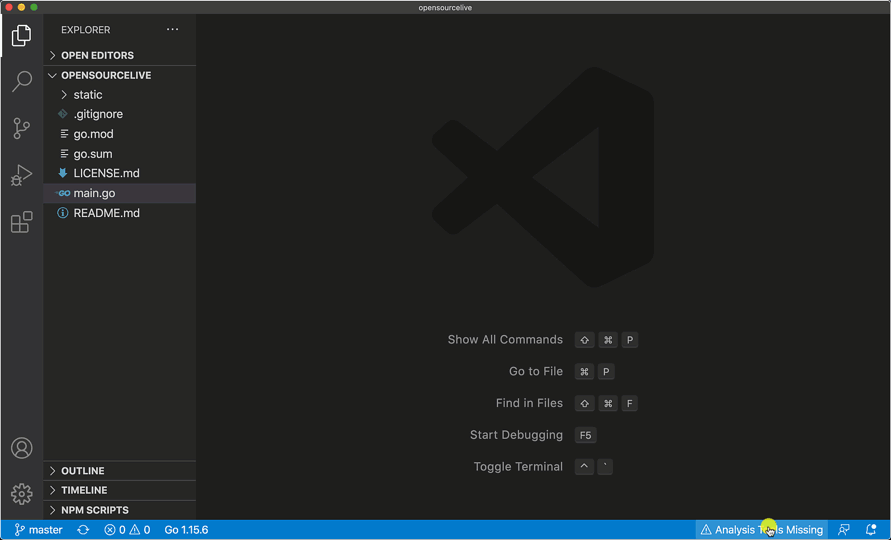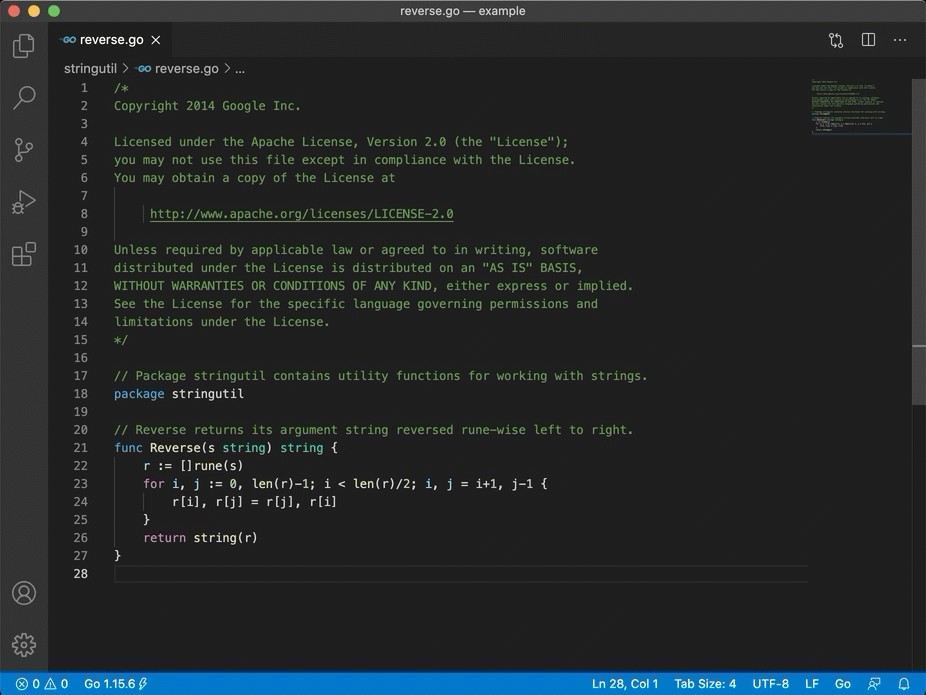The VS Code Go extension provides rich language support for the Go programming language.
📣
Remote attach debugging is now available via Delve's native DAP implementation with Delve v1.7.3 or newer.
We plan to enable this as the default in early 2022 to enhance remote debugging with the same
debugging features that are already in use for local debugging.
We recommend switching your remote attach configurations in launch.json to use
"debugAdapter":"dlv-dap" now to verify that this works for you.
Please file a new issue if you encounter any problems.
📣📣 Watch Debugging Treasure Hunt from GopherCon 2021 for a fun take on a debugging demo with VS Code Go and Delve DAP.
Welcome! 👋🏻
Whether you are new to Go or an experienced Go developer, we hope this
extension fits your needs and enhances your development experience.
- Step 1. If you haven't done so already, install Go
and the VS Code Go extension.
- Go installation guide. This extension works best with Go 1.14+.
- Managing extensions in VS Code.
- Step 2. To activate the extension, open any directory or workspace containing Go code. Once activated, the Go status bar will appear in the bottom left corner of the window and show the recognized Go version.
- Step 3. The extension depends on a set of extra command-line tools.
If they are missing, the extension will show the "
⚠️ Analysis Tools Missing" warning. Click the notification to complete the installation.
You are ready to Go :-) 🎉🎉🎉
Please be sure to learn more about the many features of this extension, as well as how to customize them. Take a look at Troubleshooting and Help for further guidance.
If you are new to Go, this article provides
the overview on Go code organization and basic go commands. Watch "Getting
started with VS Code Go" for an explanation of how to build your first Go
application using VS Code Go.
This extension provides many features, including IntelliSense, code navigation, and code editing support. It also shows diagnostics as you work and provides enhanced support for testing and debugging your programs. See the full feature breakdown for more details and to learn how to tune its behavior.

(Code completion and Signature Help)
In addition to integrated editing features, the extension provides several
commands for working with Go files. You can access any of these by opening the
Command Palette (Ctrl+Shift+P on Linux/Windows and Cmd+Shift+P on Mac), and
then typing in the command name. See the
full list of commands provided by this
extension.
For better syntax highlighting, we recommend enabling
semantic highlighting
by turning on Gopls' ui.semanticTokens setting.
"gopls": { "ui.semanticTokens": true }
The extension uses a few command-line tools developed by the Go community. In
particular, go, gopls, and dlv must be installed for this extension
to work correctly. See the tools documentation for a complete
list of tools the extension depends on.
In order to locate these command-line tools, the extension searches
GOPATH/bin and directories specified in the PATH environment variable (or
Path on Windows) with which the VS Code process has started. If the tools are
not found, the extension will prompt you to install the missing tools and show
the "Go: Install/Update Tools command.
Go modules are how Go manages dependencies in
recent versions of Go. Modules replace the GOPATH-based approach to specifying
which source files are used in a given build, and they are the default build
mode in go1.16+. While this extension continues to support both Go modules and
GOPATH modes, we highly recommend Go development in module mode. If you are
working on existing projects, please consider migrating to modules.
Unlike the traditional GOPATH mode, module mode does not require the workspace
to be located under GOPATH nor to use a specific structure. A module is
defined by a directory tree of Go source files with a go.mod file in the
tree's root directory.
Your project may involve one or more modules. If you are working with multiple modules or uncommon project layouts, you will need to configure your workspace by using Workspace Folders. Please see this documentation about supported workspace layouts.
The extension needs no configuration and should work out of the box. However, you may wish to adjust settings to customize its behavior. Please see the settings documentation for a comprehensive list of settings. See advanced topics for further customizations and unique use cases.
If the extension isn't working as you expect, you can take a look at our troubleshooting guides. There is one for general troubleshooting, and another specifically for troubleshooting the debugging feature.
If the troubleshooting guides did not resolve the issue, please reach out to us by filing an issue, starting a GitHub discussion, or by asking a question on Stack Overflow.
Also, you can take a look at go.dev/learn and golang.org/help for more general guidance on using Go.
If you'd like to get early access to new features and bug fixes, you can use the nightly build of this extension. Learn how to install it in by reading the Go Nightly documentation.
We welcome your contributions and thank you for working to improve the Go development experience in VS Code. If you would like to help work on the VS Code Go extension, please see our contribution guide. It explains how to build and run the extension locally, and describes the process of sending a contribution.
This project follows the Go Community Code of Conduct. If you encounter a conduct-related issue, please mail conduct@golang.org.


